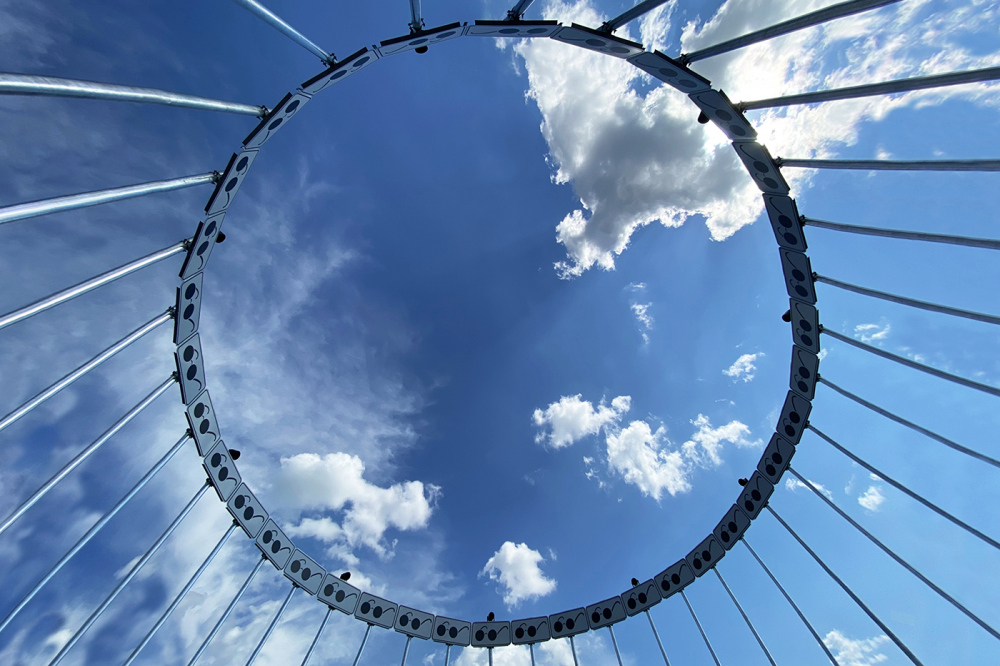-
-
PIESKARTIES SAULEI / TOUCHING THE SUN
Pielidot tuvāk saulei. Mīti un rituāli / Flying Closer to the Sun. Myths and Rituals
Cēsu mākslas festivāls 2021 / Cēsis Art Festival 2021
10 / 07 - 15 / 08 / 2021
-
[EN]
If you stare at the sun with a naked eye, light might be the last thing you will ever see. It would mean touching the sun in the most direct and ultimate way possible. Physical sight always starts with the apple of the eye, which is also round, just like the world or the sun. Eyes are like two suns in a human head. A solar eclipse is like two black suns or suns that see darkness or are darkness themselves. Sightlessness is often spoken of as a different kind of sight. In Greek mythology, Tiresias was blind and yet was able to see things hidden behind the visible world. In Schiller’s poem, the knowledge-thirsty young man’s attempt to see the truth ends not with losing his eyesight but with death. What does it mean to see?
The area hosting Cēsis Art Festival for the third-year running is known to the residents of Cēsis as the territory of the ‘blind’. This place was created during the Soviet years to centre the lives of visually impaired and sightless people around the Cēsis Training and Production Enterprise that operated under the auspices of the Latvian Society of the Blind. Pedestrian crossings on Raiņa and Krišjāņa Valdemāra streets flanking this place are equipped with an additional traffic sign ‒ ‘Sightless Pedestrians’.
In our conversations we frequently go back to Shakespeare; Gloucester, referring to the loss of his sight, says: ‘Were all the letters suns, I could not see one,’ and King Lear tells him to ‘look with thine ears’. The paradox of this thought rings very true.
The sound of Touching the Sun invites to wait. It is a miniature version of factual reality, its idea borrowed from the pedestrian crossings equipped with sound signals for the benefit of sightless people. This fragment of sound is the waiting bit that comes before crossing a road. It asks us to stop and unfolds like an ascetic infinite musical piece, transforming into a ritual.
Dzudzilo
Ilgi skatoties saulē ar neapbruņotu aci, gaisma var palikt pēdējā, ko redz. Tā būtu pavisam tieša un galīga pieskaršanās saulei. Fiziskā redzēšana vienmēr sākas ar acs ābolu, kas pats ir apaļš kā pasaule vai saule. Tās ir divas saules cilvēka galvā. Saules aptumsums kā divas melnas saules, vai tādas, kuras redz tumsu jeb pašas ir tumsa. Neredzēšana nereti ir pielīdzināta citai redzēšanai. Grieķu mitaloģijā Tirēzijs bija akls un spēja ieraudzīt to, kas slēpjas aiz redzamās pasaules. Bet Šillera poēmā patiesības ieraudzīšana zinātkārajam jaunietim beidzas nevis ar acu gaismas zaudēšanu, bet ar nāvi. Ko nozīmē ieraudzīt?
Vieta, kurā jau trešo gadu notiek Cēsu Mākslas festivāls, cēsu iedzīvotājiem ir zināma kā "neredzīgo" teritorija. Padomju laikos šī vieta tika izveidota, lai tajā koncentrētu vājredzīgu un neredzīgu cilvēku dzīves, izveidojot tajā Cēsu Neredzīgo biedrības macību un ražošanas uzņēmumu. Raiņa un Krišjāņa Valdemāra iela, kuras no divām pusēm ieskauj šo vietu, ietver gājēju pārejas, kas aprīkotas ar Ceļu satiksmes organizēšanas papildzīmi "Neredzīgi gājēji".
Savstarpējā sarunā mēs bieži atgriežamies pie Šekspīra uzrakstītajiem vārdiem, kuros Glosters, zaudējot redzi, saka - "Es neredzu, lai vai saule būtu katrs burts”, uz ko Līrs atbild “Skaties ar savām ausīm”. Šis domas paradokss ietver patiesību.
“PIESKARTIES SAULEI” skaņa aicina gaidīt. Tā ir dokumentāla realitātes miniatūra, kura aizgūta no neredzīgo gājēju pārejām, kuras aprīkotas ar skaņas signālu. Šis skaņas fragments ir gaidošā daļa, pirms ceļa šķērsošanas. Tas aicina apstāties un top kā askētisks, nebeidzams skaņdarbs, kļūstot par rituālu.
Dzudzilo
Kuratore: Daiga Rudzāte
Fotogrāfe © Dzudzilo
reinis dzudzilo ©
-
-

PIESKARTIES SAULEI / TOUCHING THE SUN
Pielidot tuvāk saulei. Mīti un rituāli / Flying Closer to the Sun. Myths and Rituals
Cēsu mākslas festivāls 2021 / Cēsis Art Festival 2021
10 / 07 - 15 / 08 / 2021
-